Say What? Black Men Are Actually Making Progress in College Enrollments
Readers of this journal are well aware of the fact that black women far outperform black men in almost every area of higher education. But contrary to much of the conventional wisdom, black males too are making progress in higher education enrollments.
In 2004 there were 758,400 black males enrolled in higher education. They made up 10 percent of all male enrollments and 4.4 percent of all enrollments in higher education.
In 1990 there were 484,700 black males enrolled in higher education. They made up 6.4 percent of all male enrollments and 3.5 percent of all enrollments in higher education. Black men are increasing their numbers in higher education and they make up a significantly larger percentage of the total enrollment than was the case 15 years ago.
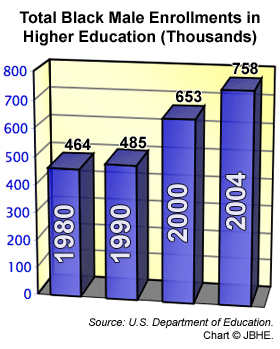
  |
“We must restore confidence in the minds of the corporations, foundations, and citizens that the mission of this college is still legitimate.”
— Willie Herenton, mayor of Memphis, Tennessee, announcing a $2.5 million bailout for historically black LeMoyne-Owen College from an anonymous donor on the condition that most of the 30 members of the board of trustees step down. This past weekend, 27 of the 30 trustees tendered their resignation.
|
The Racial Scoring Gap on the SAT at High Schools Operated by the U.S. Defense Department
According to statistics released to JBHE by the Department of Defense, white students at schools operated by the Army overseas score near the level of the nationwide average for white students at all public and private schools in the United States. But blacks at Defense Department schools routinely beat the nationwide average score for blacks who attend all public and private schools in the U.S. In 2005 the average score on the combined SAT for black students at Defense Department schools was 902, which is 38 points higher than the 864 national average for black students.
Although the racial scoring gap between blacks and whites at these schools is significantly smaller than the nationwide racial scoring gap at all schools in the United States, a large SAT scoring gap remains between blacks and whites at Army-run schools. In 2005, on the combined SAT, whites at Defense Department schools overseas scored 172 points higher than blacks at these schools. Nationally, whites on average scored 204 points higher than blacks.
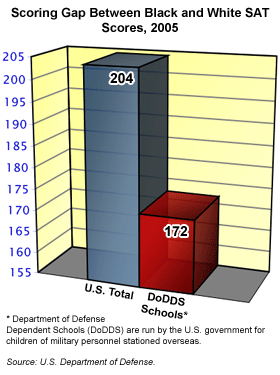
Racial Differences in the Age of Undergraduate College Students
New data from the U.S. Department of Education shows that African-American students who are enrolled in college are on average two years older than their white counterparts. The average age of a black undergraduate student is 28. For whites, the average age is 26. The median age of an African-American college student is 24 years. That means that half of all black students are older than 24 and half are younger than 24. For whites, the median age is 22 years.
Nearly 60 percent of all white students enrolled as undergraduates are 23 years or younger. For blacks, only 45.5 percent of all undergraduates are under the age of 24.
At the other end of the age spectrum, nearly 45 percent of black undergraduates are over the age of 30. For whites, 25 percent of all undergraduate students are over the age of 30. Fifteen percent of black undergraduates are over 40 years of age compared to 12.6 percent of white undergraduates.
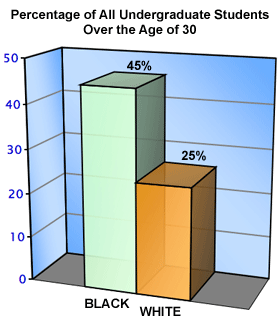

University of North Carolina
Chapel Hill

Research Associates
The Department of Public Policy at UNC-CH seeks two Research Associates for a 12-15 month funded project on work, health and social policy. The Research Associates will assist the Principal Investigator in the design and implementation of all aspects of project activities. Candidate should have a strong interest in and experience with research in health policy as well as knowledge of policies affecting low-income individuals and families. He/she must be able to analyze and interpret results of research and be able to build and maintain relationships with a variety of collaborators and groups. Master's degree in public administration, public policy or public health required.
Salary range: $40,000 - $47,000. Proposed start date mid-July. Submit resume and cover letter to Ms. Asta Crowe at Public Policy, CB #3435-UNC, Chapel Hill, NC 27599-3435.

Alabama College Desegregation Case Heading Back to Federal Court
It was more than 43 years ago when Governor George C. Wallace made his infamous “stand in the schoolhouse door” before stepping aside and allowing federal marshals to register the first black students at the University of Alabama. Since that time, there has been an ongoing struggle to bring greater racial diversity to Alabama’s public universities.
Federal district court judge Harold Murphy has set plans for a trial this fall to determine whether the state of Alabama has complied with previous orders to desegregate its state university system. Attorneys representing the black plaintiffs claim that the state’s two historically black institutions — Alabama State University and Alabama A&M University — have not been authorized to establish degree programs that will be attractive to white students. Therefore, the student bodies at these institutions remain almost entirely black.
While there has been some progress in increasing the number of black students at the University of Alabama and other predominantly white state universities in Alabama, the black percentage of the student body at these institutions is less than one half of the black percentage of the college-age population in Alabama. In addition, the plaintiffs argue that there has been only limited progress in the hiring of black faculty, administrators, and staff members at the predominantly white universities.
Plaintiffs also want the state to offer more financial aid to blacks and other students from low-income families. More than three quarters of all state financial aid to college students is based on merit rather than need.
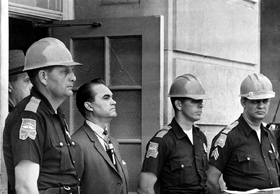
George Wallace making his infamous speech in the schoolhouse door at the University of Alabama on June 11, 1963
credit: AP Images
African Studies at Fort Valley State University Falls to the Budget Axe
 The African World Studies Institute at Fort Valley State University in Georgia will be abolished under a budget cutting proposal formulated by new university president Larry E. Rivers. There were five employees at the institute whose jobs will be eliminated. The African World Studies Institute at Fort Valley State University in Georgia will be abolished under a budget cutting proposal formulated by new university president Larry E. Rivers. There were five employees at the institute whose jobs will be eliminated.
President Rivers said that at least for the time being courses will still be offered for students in the field of African studies. A decision will be made in the near future as to whether to eliminate the entire African studies program after current students have completed their degrees. For now, courses in African studies will be held under the auspices of other academic departments at the university.
Purdue University Honors Its First Black Ph.D.
In 1967 William E. Moore, a graduate of Southern University in Louisiana, was awarded a Ph.D. in physical biochemistry at Purdue University. He was the first African American to earn a doctorate from Purdue’s College of Sciences.
 Now, in his honor, the university has endowed the William E. Moore Distinguished Professor of Earth and Atmospheric Science and Chemistry. Moore is currently a professor at Southern University. The first holder of the endowed chair will be Joseph S. Francisco, a professor of atmospheric chemistry. Professor Francisco, an African American, is a graduate of the University of Texas. He holds a Ph.D. from MIT. Now, in his honor, the university has endowed the William E. Moore Distinguished Professor of Earth and Atmospheric Science and Chemistry. Moore is currently a professor at Southern University. The first holder of the endowed chair will be Joseph S. Francisco, a professor of atmospheric chemistry. Professor Francisco, an African American, is a graduate of the University of Texas. He holds a Ph.D. from MIT.
In Memoriam
Larry D. Terry (1954-2006)
 Larry D. Terry, vice president for business affairs and professor of public administration at the University of Texas at Dallas, died, presumably, from an allergic reaction he suffered while attending an education conference in Atlanta. Dr. Terry was known to be allergic to seafood. Larry D. Terry, vice president for business affairs and professor of public administration at the University of Texas at Dallas, died, presumably, from an allergic reaction he suffered while attending an education conference in Atlanta. Dr. Terry was known to be allergic to seafood.
A native of Tulsa, Oklahoma, Terry was a graduate of Lincoln University of Missouri. He held a master’s degree from the University of Missouri and a Ph.D. from Virginia Tech. Terry, a distinguished scholar, was editor of the journal Public Administration Review. He was the author of two books: The Leadership of Public Bureaucracies and Administrative Interpretation of Law.
Terry came to the University of Texas at Dallas in 2001. Previously he taught at Radford College in Virginia and Cleveland State University.
Appointments
 • Antoine M. Garibaldi, president of Gannon University in Erie, Pennsylvania, was elected chair of the board of directors of the Council of Independent Colleges. As chair he will represent the 550-member association on the board of directors of the American Council on Education. • Antoine M. Garibaldi, president of Gannon University in Erie, Pennsylvania, was elected chair of the board of directors of the Council of Independent Colleges. As chair he will represent the 550-member association on the board of directors of the American Council on Education.
 • Bettye Young-Stewart was named assistant director for operations and compliance at the Sebastian Health Center on the campus of North Carolina A&T State University. She has been serving in the post as interim director. • Bettye Young-Stewart was named assistant director for operations and compliance at the Sebastian Health Center on the campus of North Carolina A&T State University. She has been serving in the post as interim director.
Young-Stewart is a graduate of Shaw University in Raleigh, North Carolina. She holds a master’s degree from North Carolina A&T State University.
|
College Students From Black Africa Are the Most Likely to Enroll at Educational Institutions Outside Their Native Land
 According to a new report from the United Nations Educational, Scientific and Cultural Organization (UNESCO), in 2004 more than 2.5 million college students were enrolled in institutions outside their native countries. Some 23 percent of these students were enrolled at colleges and universities in the United States. According to a new report from the United Nations Educational, Scientific and Cultural Organization (UNESCO), in 2004 more than 2.5 million college students were enrolled in institutions outside their native countries. Some 23 percent of these students were enrolled at colleges and universities in the United States.
Students from black African nations were the most likely to attend college abroad. One of every 16 black African college students was enrolled in a foreign educational institution. The nations of Guinea-Bissau, Djibouti, Comoros, and Cape Verde had more students studying abroad than they did within their own borders.
Students from North America were least likely to attend a university outside their native land. Less than one half of one percent of all American college students were enrolled in foreign educational institutions.
Emory University to Develop an Internet Database of More Than 27,000 Slave Ship Voyages
 Emory University in Atlanta has received a $324,000 grant from the National Endowment for the Humanities to create a website which will document more than 80 percent of the slave trade voyages that occurred across the Atlantic Ocean. The database documents more than 27,000 voyages made by slave ships during the colonial period. Emory University in Atlanta has received a $324,000 grant from the National Endowment for the Humanities to create a website which will document more than 80 percent of the slave trade voyages that occurred across the Atlantic Ocean. The database documents more than 27,000 voyages made by slave ships during the colonial period.
The new Internet site will include ship logs, manifests, and maps showing the routes the ships took. The material will be presented in two formats: one for historical scholars and a second for use in K-12 educational classes.
The project is under the direction of David Eltis, Robert W. Woodruff Professor of History at Emory University.
Black Students Enrolled in Master’s Degree Programs Are Facing Rising Amounts of Debt
 New data from the U.S. Department of Education shows that 81.7 percent of all black students enrolled in master’s degree programs received some amount of financial aid. But for all the black students who receive financial assistance of any type, only 40 percent receive outright scholarship grants. New data from the U.S. Department of Education shows that 81.7 percent of all black students enrolled in master’s degree programs received some amount of financial aid. But for all the black students who receive financial assistance of any type, only 40 percent receive outright scholarship grants.
More than 57 percent of all black students in master’s degree programs take on debt in order to finance their education. Only 38 percent of white graduate students take out student loans. Black students who take out student loans incur an average annual debt of $14,300, $1,200 more than the average annual debt load incurred by whites.
The unwillingness to take on such a large amount of debt undoubtedly causes many black students to forgo graduate or professional school education.
Moravians Apologize for Slavery
 The Moravian Church was founded in the fifteenth century in what is now the Czech Republic. Fleeing religious persecution, some Moravians came to America in 1735 and in 1741 founded the city of Bethlehem, Pennsylvania. Moravian College in Bethlehem was established in 1742. It is now the sixth-oldest college in the United States. At the current time, only 2 percent of the students at Moravian College are black. The Moravian Church was founded in the fifteenth century in what is now the Czech Republic. Fleeing religious persecution, some Moravians came to America in 1735 and in 1741 founded the city of Bethlehem, Pennsylvania. Moravian College in Bethlehem was established in 1742. It is now the sixth-oldest college in the United States. At the current time, only 2 percent of the students at Moravian College are black.
At the time of the founding of the college, some of the Moravian settlers owned black slaves. While there is no evidence that slaves were used to work on the construction of the campus, it is quite possible that some did so. The black slaves in the Moravian community were permitted to worship God alongside their masters, and when they died, they were buried in the same cemeteries.
Now the Moravian Church has issued a formal apology to African Americans for its ties to slavery. Calling the era the “low point of Moravians in North America,” the Church vowed that it would now make a concerted effort to reach out to the African-American community.
Due to extensive missionary work in Africa and the West Indies, only about one tenth of all Moravians worldwide are white.
The College Board Offers a New Guide for Consideration of Race in College Admissions in the Post-Grutter Era
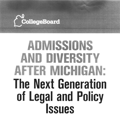 The College Board has released a new manual entitled Admissions and Diversity After Michigan: The Next Generation of Legal and Policy Issues. The manual is meant as a guide for college admissions officials to give them advice on what will be allowed and what will not be permitted by the courts in the aftermath of the Grutter ruling. The manual discusses race-neutral alternatives to race-sensitive admissions and how universities can make the case that racial diversity is essential to the overall learning environment. The College Board has released a new manual entitled Admissions and Diversity After Michigan: The Next Generation of Legal and Policy Issues. The manual is meant as a guide for college admissions officials to give them advice on what will be allowed and what will not be permitted by the courts in the aftermath of the Grutter ruling. The manual discusses race-neutral alternatives to race-sensitive admissions and how universities can make the case that racial diversity is essential to the overall learning environment.
The manual is coauthored by Arthur L. Coleman and Scott R. Palmer, who both served as deputy assistant secretary of education for civil rights during the Clinton administration.
The full report can be downloaded by clicking here.
  |
92.7% Percentage of white adults in 2003 who had 25 or more books in their home.
81.8% Percentage of black adults in 2003 who had 25 or more books in their home.
source: U.S. Department of Education
|
Bethune-Cookman College to Double the Size of Its Nursing School
 Bethune-Cookman College is planning to double the size of its nursing school. The historically black educational institution in Daytona Beach, Florida, has raised nearly $2 million to buy land and a building that was the site of an automobile dealership. After renovations are completed the building will house eight classrooms, a 300-seat lecture hall, and three laboratories. Bethune-Cookman College is planning to double the size of its nursing school. The historically black educational institution in Daytona Beach, Florida, has raised nearly $2 million to buy land and a building that was the site of an automobile dealership. After renovations are completed the building will house eight classrooms, a 300-seat lecture hall, and three laboratories.
Bethune-Cookman looks to increase enrollments from about 55 new nursing students each year to 120 new students.
Morehead State Budgets $1 Million for Efforts to Increase Racial Diversity on Campus
 Morehead State University is a predominantly white university located in a rural part of northeastern Kentucky, an area with a small black population. As a result, only 3.5 percent of the students at the 7,700-undergraduate campus are black. Only 36 percent of the entering black students go on to earn a bachelor’s degree. There are 15 black faculty members at the university. They make up less than 4 percent of the total faculty. Morehead State University is a predominantly white university located in a rural part of northeastern Kentucky, an area with a small black population. As a result, only 3.5 percent of the students at the 7,700-undergraduate campus are black. Only 36 percent of the entering black students go on to earn a bachelor’s degree. There are 15 black faculty members at the university. They make up less than 4 percent of the total faculty.
But Wayne Andrews, the new president of Morehead State, is mounting an effort to significantly increase racial diversity on campus. He has budgeted nearly $1 million to recruit black students, offer scholarships to low-income undergraduates, increase cultural activities on campus geared toward black students, and to offer incentives to black faculty to come to Morehead.
Morehouse College Graduate Takes the Helm at Ebenezer Baptist Church
 Raphael Gamaliel Warnock was named the fifth pastor of the 119-year-old, 2,200-member Ebenezer Baptist Church in Atlanta. Martin Luther King Jr. was pastor of the church from 1960 to 1968. Raphael Gamaliel Warnock was named the fifth pastor of the 119-year-old, 2,200-member Ebenezer Baptist Church in Atlanta. Martin Luther King Jr. was pastor of the church from 1960 to 1968.
Warnock, who gave his first sermon at age 11, is a 1991 graduate of Morehouse College where he majored in psychology. Now 36 years old, Warnock holds a master of divinity degree and a master of philosophy degree from Union Theological Seminary in New York. He is currently a Ph.D. candidate in systematic theology at Union Theological Seminary.
Meet the New President of Bowie State University
 Mickey L. Burnim, president of Elizabeth City State University in North Carolina, has accepted an offer to become president of Bowie State University in Maryland. Bowie State has about twice as many students enrolled as Elizabeth City State. Burnim has been an administrator in the University of North Carolina system since 1982. He was named president of Elizabeth City State in 1996. During his tenure he increased enrollments from 1,980 to 2,600 and he introduced three new master’s degree programs. Mickey L. Burnim, president of Elizabeth City State University in North Carolina, has accepted an offer to become president of Bowie State University in Maryland. Bowie State has about twice as many students enrolled as Elizabeth City State. Burnim has been an administrator in the University of North Carolina system since 1982. He was named president of Elizabeth City State in 1996. During his tenure he increased enrollments from 1,980 to 2,600 and he introduced three new master’s degree programs.
Burnim is a graduate of North Texas State University. He holds a Ph.D. in economics from the University of Wisconsin.
Burnim is expected to assume his new duties on September 1.
Hampton University Receives Massive Donation of Books
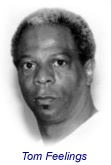 Tom Feelings, who was a professor of art at the University of South Carolina, illustrated 20 books in his lifetime with most of the pictures depicting black children or images of slavery. Feelings died in 2003 at the age of 70. Tom Feelings, who was a professor of art at the University of South Carolina, illustrated 20 books in his lifetime with most of the pictures depicting black children or images of slavery. Feelings died in 2003 at the age of 70.
Now his heirs have donated Feelings’ massive personal library to Hampton University. The collection includes more than 5,000 books, most of which are related to art and illustration.
New Minority-Owned Company to Market College Student Loans to Blacks
Robert L. Johnson, the founder of Black Entertainment Television, is launching a new business that will concentrate on making loans to African-American, minority, and low-income college students. The new firm, UTB Education Finance, will be partially owned by Goldman Sachs.
The company will offer loans to all college students at rates comparable to other loan companies. But UTB will concentrate its marketing efforts on groups that traditionally have been reluctant to borrow to finance higher education. As a minority-owned firm, UTB believes it will have an edge in marketing its services to black and other minority students, many of whom tend to have a great mistrust of white-controlled financial institutions.
UTB plans to start making loans for the spring 2007 semester.

Grants
• Huston-Tillotson University, the historically black educational institution in Austin, Texas, received a $100,000 grant from the Wachovia Foundation to support the university’s Business Resource and Training Center.
• The Law School Admission Council has awarded a $540,000 grant to the Educational Diversity Project to study whether racial diversity in U.S. law schools produces benefits to society. Scholars at the University of North Carolina at Chapel Hill, the University of North Carolina at Greensboro, and the University of California at Los Angeles will participate in the research.
• Florida International University’s Center for Diversity in Engineering received a $50,000 grant from the AT&T Foundation for a program to increase the number of black and other minority students in the field of engineering. The university will use the grant to fund an after-school science academy for middle school students in Homestead, Florida.
|

